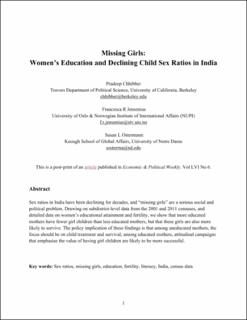| dc.contributor.author | Chhibber, Pradeep | |
| dc.contributor.author | Jensenius, Francesca R. | |
| dc.contributor.author | Ostermann, Susan | |
| dc.date.accessioned | 2022-07-22T08:56:01Z | |
| dc.date.available | 2022-07-22T08:56:01Z | |
| dc.date.created | 2021-02-26T10:19:17Z | |
| dc.date.issued | 2021 | |
| dc.identifier.citation | Economic and Political Weekly. 2021, 56 (6) | en_US |
| dc.identifier.issn | 0012-9976 | |
| dc.identifier.uri | https://hdl.handle.net/11250/3007749 | |
| dc.description.abstract | Sex ratios in India have been declining for decades, and “missing girls” are a serious social and political problem. Drawing on subdistrict-level data from the 2001 and 2011 Censuses and detailed data on women’s education and fertility, we show that more-educated mothers have fewer girl children than less-educated mothers, but that these girls are also more likely to survive. The policy implication of these findings is that among uneducated mothers, the focus should be on child treatment and survival; among educated mothers, attitudinal campaigns that emphasise the value of having girl children are likely to be more successful. | en_US |
| dc.language.iso | eng | en_US |
| dc.relation.uri | https://t.co/TgbgmBsvB0?amp=1 | |
| dc.title | Missing Girls: Women’s Education and Declining Child Sex Ratios in India | en_US |
| dc.type | Peer reviewed | en_US |
| dc.type | Journal article | en_US |
| dc.description.version | acceptedVersion | en_US |
| dc.source.journal | Economic and Political Weekly | en_US |
| dc.identifier.cristin | 1893957 | |
| dc.relation.project | Norges forskningsråd: 250753 | en_US |
| cristin.ispublished | true | |
| cristin.fulltext | postprint | |
| cristin.qualitycode | 1 | |
